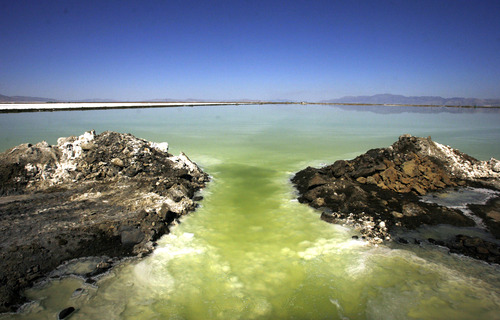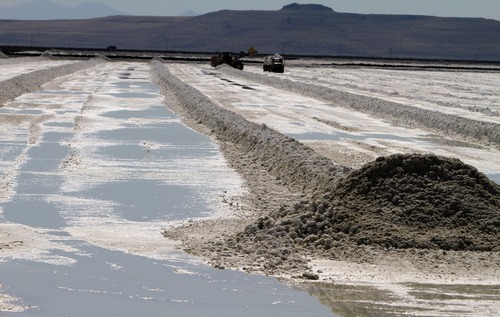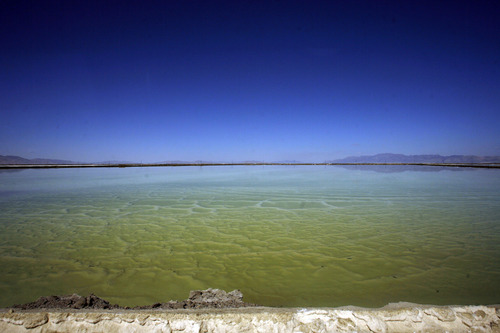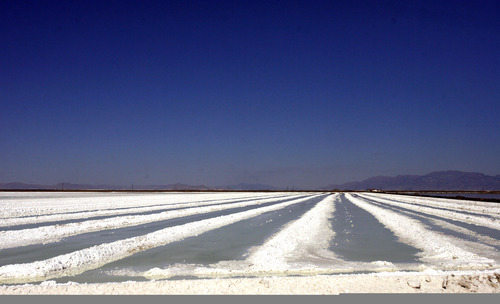This is an archived article that was published on sltrib.com in 2013, and information in the article may be outdated. It is provided only for personal research purposes and may not be reprinted.
Great Salt Lake Minerals Corp. has submitted a revised, smaller plan to expand its solar evaporation pond system on the shores of the Great Salt Lake in hopes of easing concerns about its efforts.
The Ogden-based company has 47,000 acres of solar evaporation ponds on the eastern side of the lake near Ogden and on the western shores. The sun evaporates brine in the ponds, which leaves sulfate of potash, used as a fertilizer for fruits, vegetables and nuts, along with other minerals.
The new plan, which replaces the company's expansion projects from several years ago, is the result of further study of the ecology of the lake, the company's technological advances and direct discussions with environmental organizations, said spokesman Dave Hyams.
Lynn de Freitas, executive director of Friends of Great Salt Lake, praised the company for discussing concerns with conservationists and user groups.
"We haven't seen the final, specific details, so we don't know what kind of mitigation will be proposed to account for impacts on the lake," she added. "Even though there will be a smaller footprint on the lake, the lake will suffer impacts."
The company insists that because of technological advancements, the new project will require no additional water withdrawals from the lake, which had been a sticking point with opponents. In addition, two of the three expansion phases would not be near avian areas on Bear River Bay on the eastern side of the lake, which had been the source of another earlier conflict.
The new plan calls for a maximum 52,000 acres of additional solar evaporation ponds, a drop of more than 40 percent from the 91,000 acres requested in 2009, with most of the new ponds on the lake's remote northwest side, said Hyams.
The new proposal also withdraws an earlier request for 353,000 acre feet per year of water rights. This change is aimed at preserving lake levels. In addition, unused minerals would be returned to the lake sooner, which would benefit salinity levels.
The project is divided into three stages:
Immediate expansion • In Phase A, the company would add approximately 10,000 acres of new ponds on the west side of the lake adjacent to existing ponds, and approximately 14,000 acres of new ponds on the west side in areas outside the lake. There would be no development on the east side of the lake. Work would begin as soon as a permit is issued.
Around 2020 • When demand for the company's crop nutrients can no longer be met by production from these ponds alone, the company would add approximately 11,000 acres of solar ponds on the west side of the lake, north and east of GSL Minerals' existing ponds.
30-year-plan • The company's final stage would add 11,800 acres of ponds on the west side of the lake, up to 3,500 acres of new ponds south and west of Promontory Point, and 1,200 acres of new ponds on the east side of the lake near Bear River Bay.
John Urbanic, senior project manager for the Army Corp. of Engineers, said the agency will decide appropriate steps to follow, including timetables for hearings, once the application is evaluated.
Twitter@DawnHouseTrib —
GSL Minerals
The company, which has been operating on the shores of Great Salt Lake since 1970:
Produces • 400,000 tons of sulfate of potash (SOP) fertilizer annually
Manages • 47,000 acres of solar evaporation ponds on shores near Ogden
Employs • 350 associates and 80 contractors at its Ogden facility
Parent firm • GSL is a subsidiary of Kansas City-based Compass Minerals













